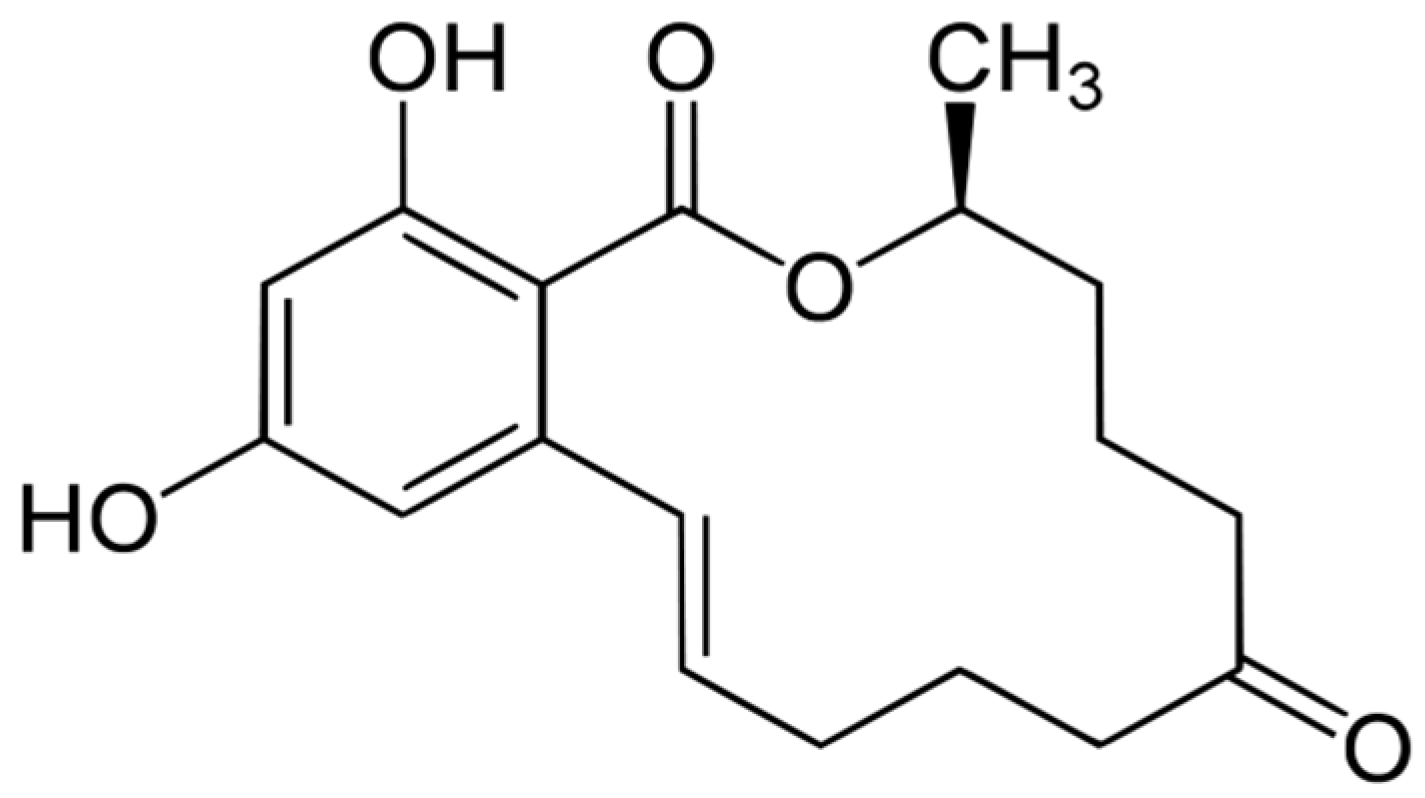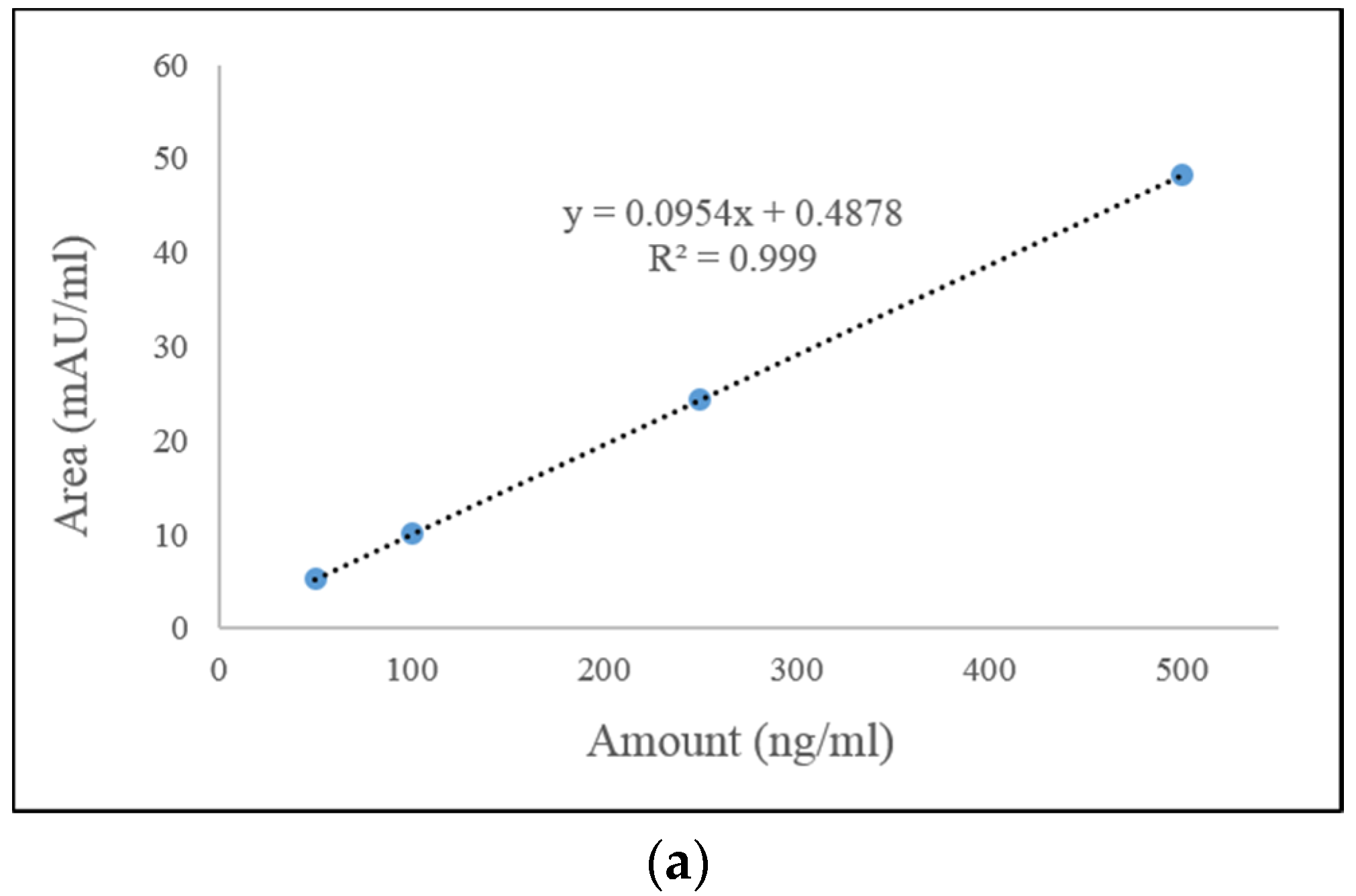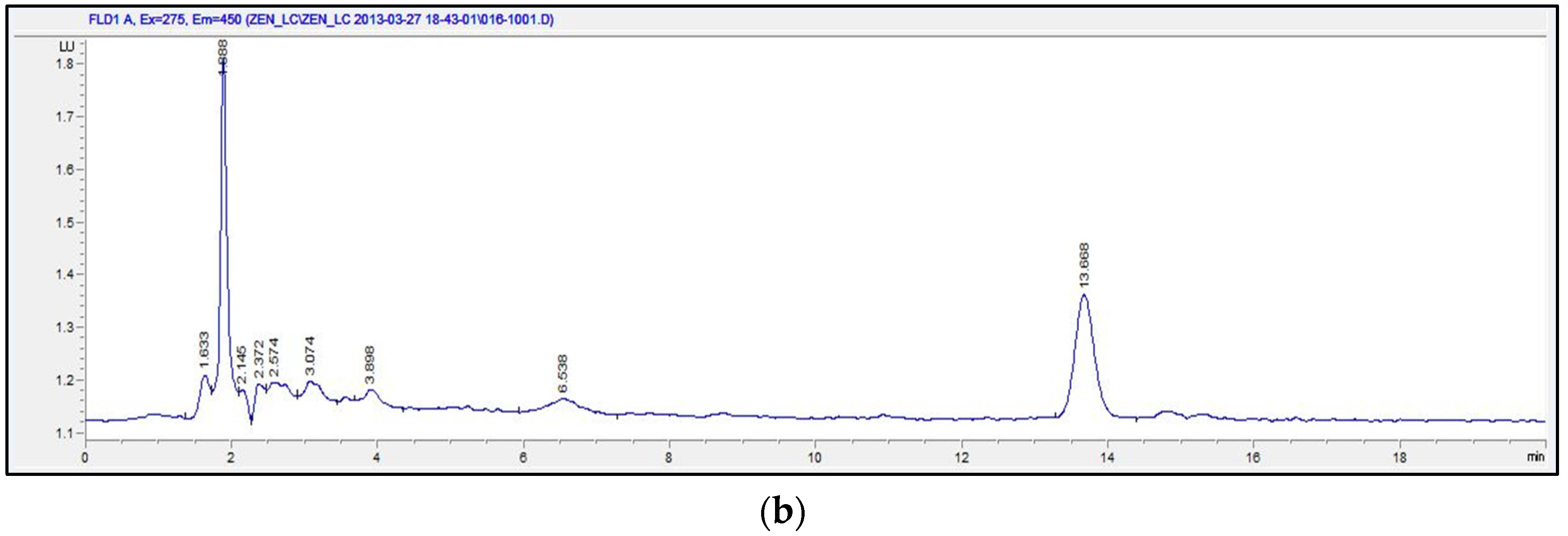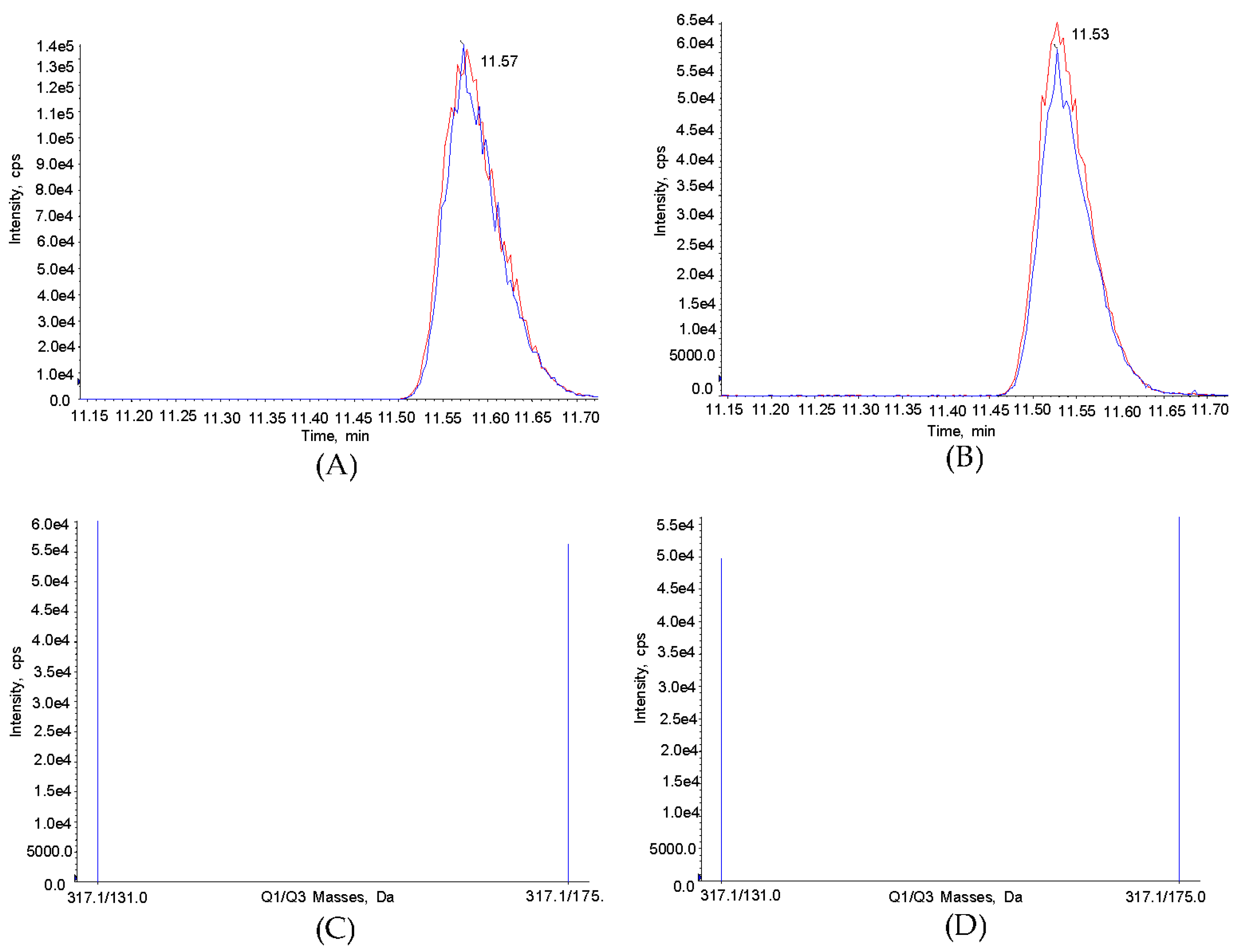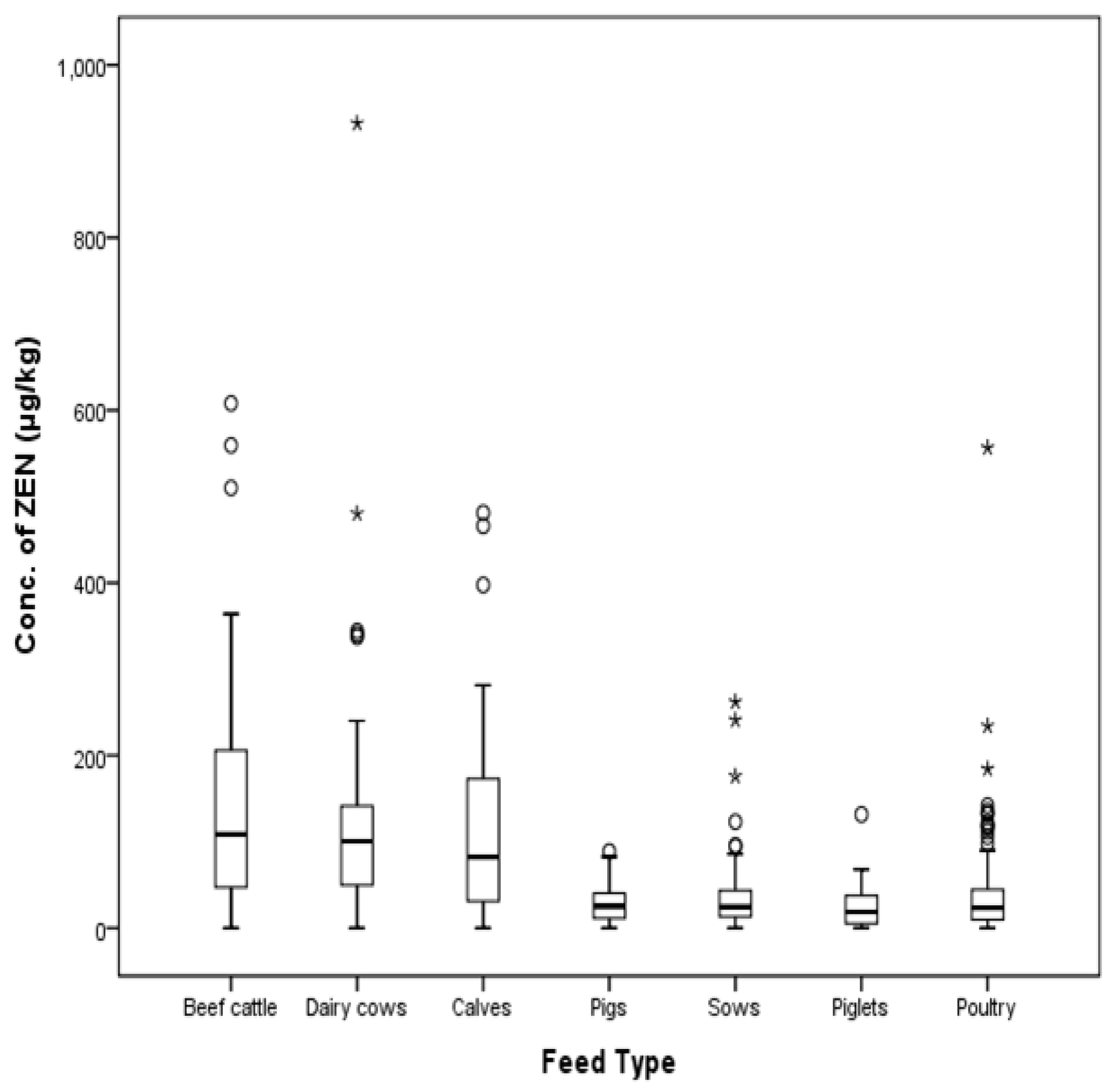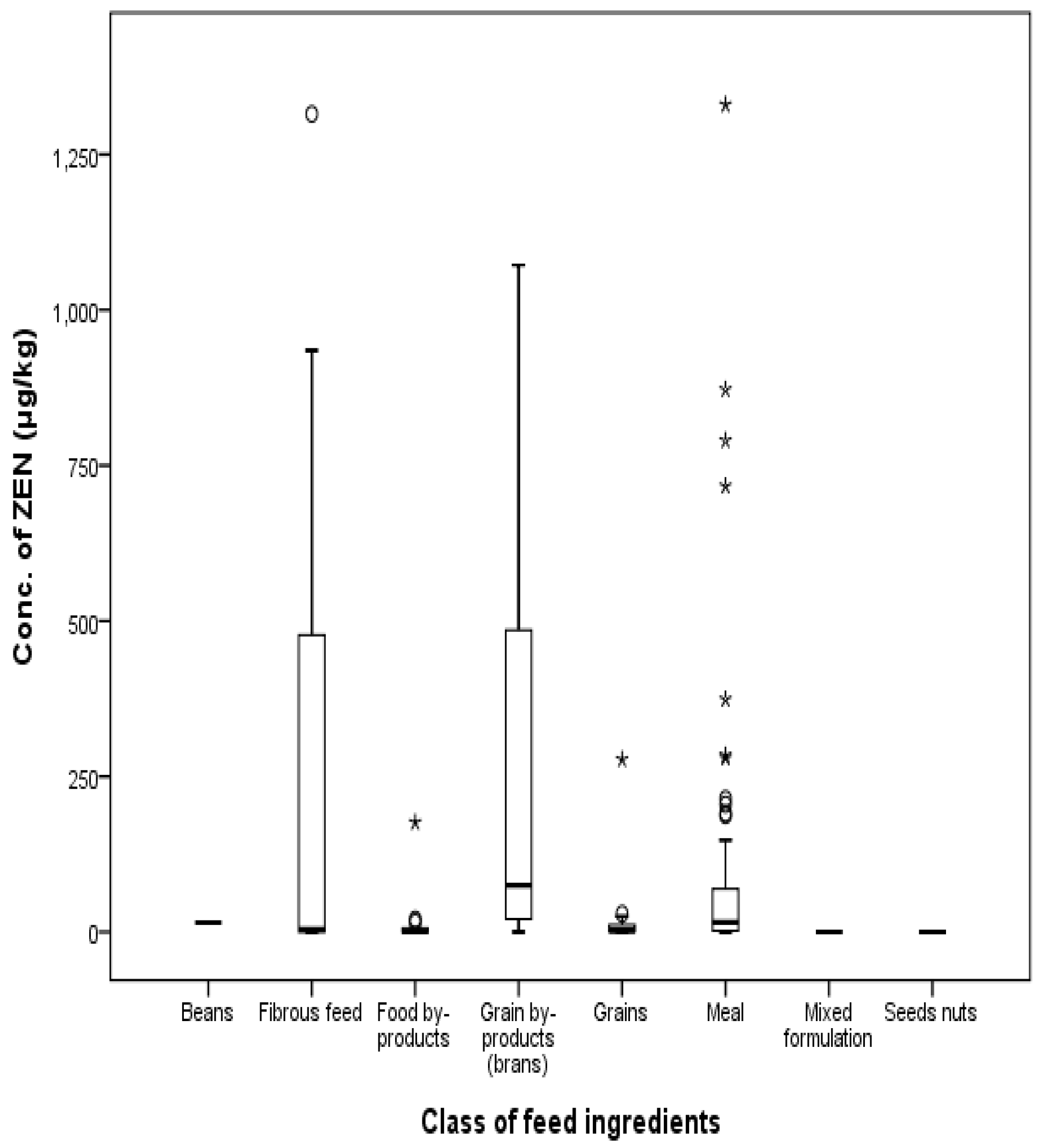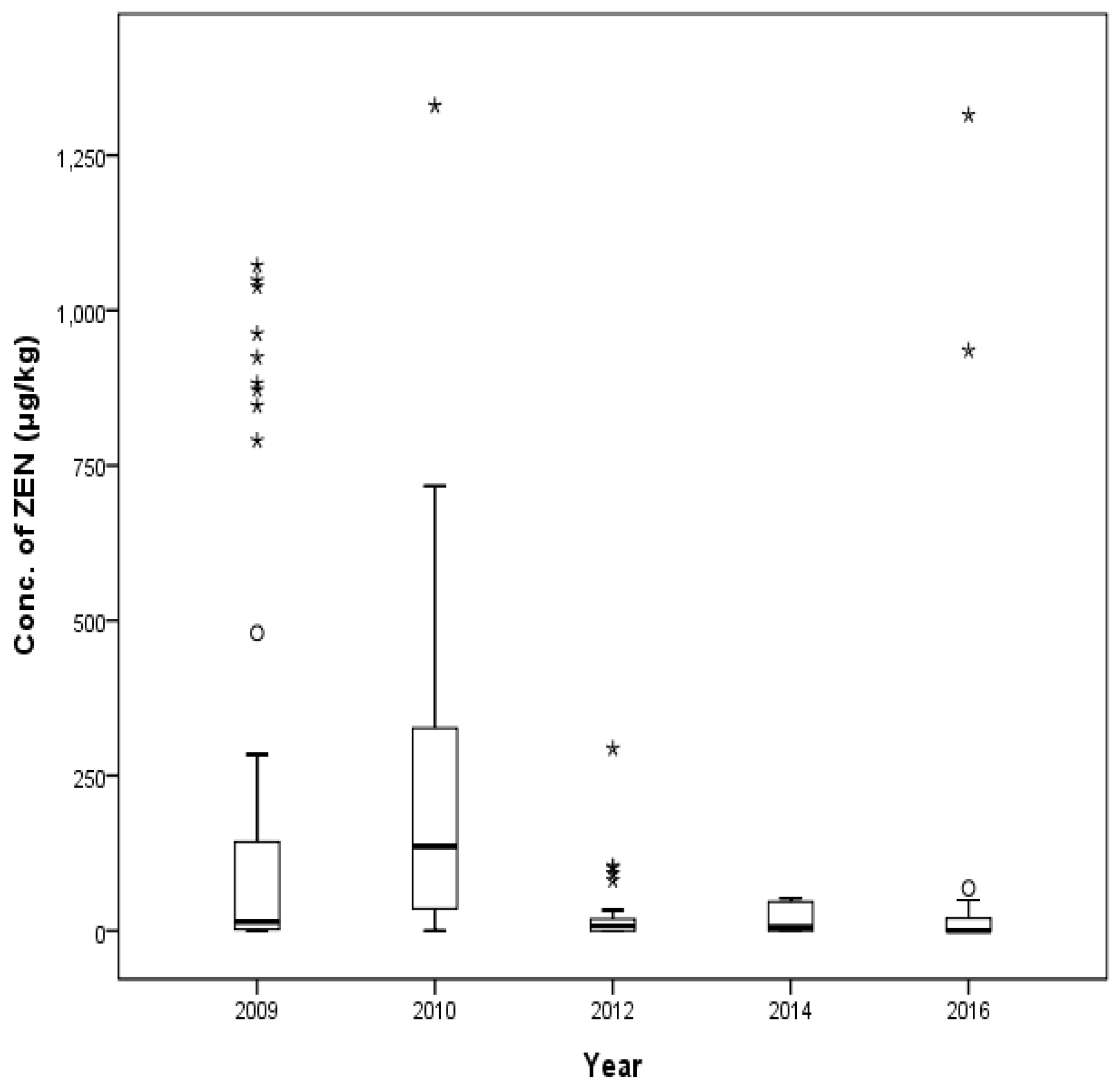1. Introduction
Mycotoxins are secondary metabolites produced by fungi such as
Fusarium,
Aspergillus, or
Penicillium genera during crop cultivation or storage processes [
1]. Mycotoxins have been increasingly mentioned worldwide as an important issue because of their acute and chronic toxicity to humans and animals [
2]. Many
Fusarium mycotoxins, including deoxynivalenol (DON), zearalenone (ZEN), and fumonisin (FUM), are distributed widely in food and animal feed and can cause different diseases in humans, animals, and even in plants [
3]. One of the well-known
Fusarium mycotoxins, zearalenone (ZEN), is a white crystal granule exhibiting a melting point of 164~165 °C and a maximum absorbance at 264 nm in UV-absorption. ZEN is insoluble in water due to its hydrophobicity, but is soluble in water-soluble alkali and other organic solvents. The level of ZEN in crops is not reduced during storage or processing at high temperature because of its heat stability [
4]. The chemical structure of ZEN is shown in
Figure 1.
ZEN causes hyperestrogenism and toxicosis resulting in reproductive dysfunction in animals because it competitively binds to the mammalian estrogen acceptor. Pigs are reported as the most susceptible animal to ZEN among livestock [
5]. Acute toxicity of ZEN by sub-acute exposure is relatively low, and its lethal dose was reported as over 4000 mg/kg (b.w.). Due to its low toxicity, the International Agency for Research on Cancer (IARC) classified ZEN in group 3 (not classifiable as carcinogenic to humans) [
6].
Grains, grain byproducts, and vegetable proteins found in animal feed are major nutrient sources for the growth of fungi [
7]; therefore, mycotoxins produced by fungi in animal feeds are an important management issue in feed safety. In Korea, 18,640 tons of compound feed were produced domestically in 2012, and 15,350 tons of feed ingredients were imported in the same year from major exporting countries such as the USA, Canada, Europe, China, South Africa, South-East Asia, India, and Australia. This variety of feed ingredients from different countries leads to difficulty in controlling mycotoxin levels in compound feeds.
In Turkey, cattle feeds were contaminated with ZEN in 45.2% of tested samples [
8], and feed ingredients were contaminated with ZEN in 31.58% of total samples [
9]. In Slovakia, 88% of tested poultry feed samples were contaminated with ZEN in 2004 [
10]. In Asia and Oceania, Binder et al. reported mean ZEN contamination level of 0.077 mg/kg in feed ingredients [
11]; in Korea, ZEN was detected in 98% of tested feeds, with concentrations ranging from 0.009 to 0.405 mg/kg [
12].
The European Commission (EU) has suggested guidelines for maximum aflatoxin, ochratoxin, or other
Fusarium mycotoxin levels in animal feeds, and the USA has also defined guidelines for aflatoxin (AFT), deoxynivalenol (DON), and fumonisin (FUM) in feeds [
13]. So far, the levels of AFT and OCT in animal feeds have been controlled according to the guidelines for livestock control and fish feed acts in South Korea; recently, the guidelines for
Fusarium mycotoxins were set based on the monitoring results and guidelines of the European Union (EU). In this study, data on the contamination levels of ZEN in animal feeds that were collected for many years are reported, and the contamination risk of ZEN in animal feeds in Korea is discussed. The guidelines for ZEN in the EU and South Korea are shown in
Table 1.
3. Discussion
Various studies have been performed worldwide to determine contamination levels of ZEN in compound feeds. In Germany, monitoring of ZEN data in 2008 for a total of 246 compound feeds showed that 38% of 69 sucking piglet feeds, 35% of 51 sow feeds, and 33% of 126 growing pig feeds were contaminated with ZEN [
17]. The maximum level of ZEN was 100 μg/kg in sucking piglet feeds and sow feeds. One compound feed for growing pigs exhibited the highest contamination level (400 μg/kg), which exceeded the EU commission regulation (250 μg/kg). In Poland from 2006 to 2009, ZEN was detected in most compound feeds (72% to 100% out of 183 samples) [
18]. The maximum contamination levels of ZEN in total feeds ranged from 44 to 229 μg/kg with a mean of 11 to 17 μg/kg in that report. Another study showed a similar contamination ratio of 91 to 100% from 428 compound feeds [
19]. The level of ZEN contamination in compound feeds was estimated as 99% of 92 samples in the Republic of South Africa. Interestingly, 51% of 47 compound feeds were contaminated with ZEN over the limit of quantitation. The detection rate of ZEN in total feeds ranged from 30 to 610 μg/kg with a mean of 88 μg/kg. The cattle feeds were contaminated with ZEN with 123 μg/kg of maximum level and 72 μg/kg of mean level. The poultry feeds exhibited the maximum contamination level of 610 μg/kg and a mean contamination level of 100 μg/kg. None of the feeds exceeded the EU commission regulations [
19]. Similarly, ZEN was detected in 89% of 53 chicken feeds with a mean of 55.6 μg/kg and ranged from 0 to 400 μg/kg in Kuwait [
20]. ZEN was detected in 31.7% of compound feeds out of 180 samples with a mean value of 7.79 μg/kg (range of 2.1~29.3 μg/kg) in Turkey [
8]. In Croatia, 93% of 30 growing pig feeds were contaminated with ZEN over a range from 8.93 to 866 μg/kg, and the mean contamination level was 184 μg/kg. Contamination levels of ZEN in five feed samples exceeded the EU commission regulation (250 μg/kg) [
21]. In the Netherlands, ZEN was detected in 28% of 72 dairy cow feeds with a mean contamination level of 80 μg/kg and a maximum concentration of 363 μg/kg [
22]. Three piglet feeds exceeded the EU commission regulation with levels ranging from 171 to 229 μg/kg in Poland [
18]. According to monitoring research performed in Germany, Poland, and Croatia, the contamination level of ZEN in pig feeds should be regulated because pig feeds showed the highest concentration of ZEN that exceeded the EU commission regulations.
In this study, ZEN contamination level was estimated in 494 compound feed samples (174 cattle feeds, 160 pig feeds, and 160 poultry feeds) distributed in South Korea between 2009 and 2016 (2009, 2010, 2012, 2014, and 2016). Most of the tested compound feeds were contaminated with ZEN ranging from 1 to 932 μg/kg (a mean of 70 μg/kg). ZEN was detected in 89% of 54 piglet feeds distributed in South Korea, with one case (one weanling piglet feed) exceeding EU and South Korea regulation levels by 132 μg/kg. In growing pig feeds, ZEN was detected in 98% of 48 samples at a maximum contamination level of 89 μg/kg. The 98% of 58 sow compound feeds were contaminated with ZEN, and one feed sample for gestating sows showed maximum contamination concentrations of 262 μg/kg, which were higher than listed in the EU commission and South Korea regulations (250 μg/kg for sows compound feeds). In the case of beef compound feeds, three compounds including one lactating beef cattle feed in 2016 (510 μg/kg) and one high yielding dairy cow feed in 2014 (932 μg/kg) showed high ZEN contamination levels that were higher than those listed in the EU commission regulations (500 μg/kg for dairy cattle) and South Korea regulations (500 μg/kg for ruminant). The mean ZEN contamination level (70 μg/kg) ranged from 11 to 269 μg/kg in compound feeds distributed in Korea and was slightly higher than that of Poland and lower than that of the Republic of South Africa.
The contamination of ZEN in feed ingredients has also been reported in many other countries. Döll & Dänicke reported that 75% of corn feeds out of 95 samples were contaminated with ZEN in Germany. However, grains showed a much lower contamination ratio (24% out of 499 samples). There was no feed exhibiting higher ZEN contamination levels than the EU commission regulations [
17]. Even though there were no case reports related to a higher contamination of ZEN in feed ingredients in Germany, some compound feeds such as sow feed showed relatively high ZEN contamination levels that were close to the EU commission regulations (100 μg/kg). Furthermore, a growing pig feed exhibited very high ZEN contamination levels (400 μg/kg) that exceed the EU commission regulations (250 μg/kg) despite the low contamination level of ZEN in feed ingredients in corn and grains [
17]. In Kuwait, Beg et al. reported that most wheat bran, soybean meal, and corn feed ingredients were contaminated with ZEN, with a mean contamination level of 51 μg/kg and maximum contamination concentration of 99.6 μg/kg [
20]. Research performed in the United Kingdom also showed that the detection frequency and mean contamination level of corn gluten meals were 20% and 50~480 μg/kg, respectively [
23]. Also, it has been reported that ZEN was found in corn bran at 245.6 μg/kg in South Africa [
24]. Interestingly, ZEN was not detected in corn from Brazil [
25]. The incidence rate of ZEN contamination in feed ingredients was 92.3% in China [
26,
27] and 92% in Upper Egypt [
28]. Njobeh et al. performed a study in the Republic of South Africa and reported that contamination level in cattle feeds was higher than that in feeds of other animals, but this difference in animal feed had no direct connection with the content of corn in each feed. The content of corn in pig and poultry feeds was higher relative to that in cattle feed [
19].
In feed ingredients distributed in South Korea, 77% of the total samples including grains, grain byproducts, meal, fibrous feed, food byproducts, and others (beans, seeds nuts, and mixed formulation) were found to be contaminated, with incidence levels of 77%, 83%, 82%, 50%, 62%, and 25%, respectively. ZEN was detected in all 17 grains, but the contamination levels did not exceed the EU commission regulation (2000 μg/kg). Mean ZEN contamination level in grains was estimated as 19 μg/kg. Sixteen soybean meal samples were also contaminated with ZEN at a 5 μg/kg mean contamination level, which was lower than that of other countries. The mean contamination level of distillers dried grain was analyzed as 81 μg/kg, which was similar to the results of a previous study. The mean contamination level of feed ingredients related to corn was 324 μg/kg (2009), 270 μg/kg (2010), 67 μg/kg (2012), 46 μg/kg (2014), and 20 μg/kg (2016). In our previous report in 2014 [
12], which was performed separately in other research project with different samples, similar results were found in the contamination levels of the ZEN in animal feeds. Most compound feeds for cattle were contaminated with this mycotoxin, and the highest level of ZEN contamination was 405 µg/kg in cattle fatting feeds.
The ZEN contamination level in feed needs to be compared over many years to assess the relevance of ZEN contamination between feed ingredients and compound feeds, and monitoring enough feed ingredient samples over long periods of time is recommended. The reason why incongruent ZEN levels were found in compound feeds despite using the same feed ingredients that did not exceed the EU commission regulations might be due to higher ZEN regulation standards in feed ingredients. If feed ingredients with high ZEN levels are used to produce compound feed, the level of ZEN in the resultant compound feed could exceed the regulation guideline because the guideline for ZEN in feed ingredients is much higher than that for compound feed.
